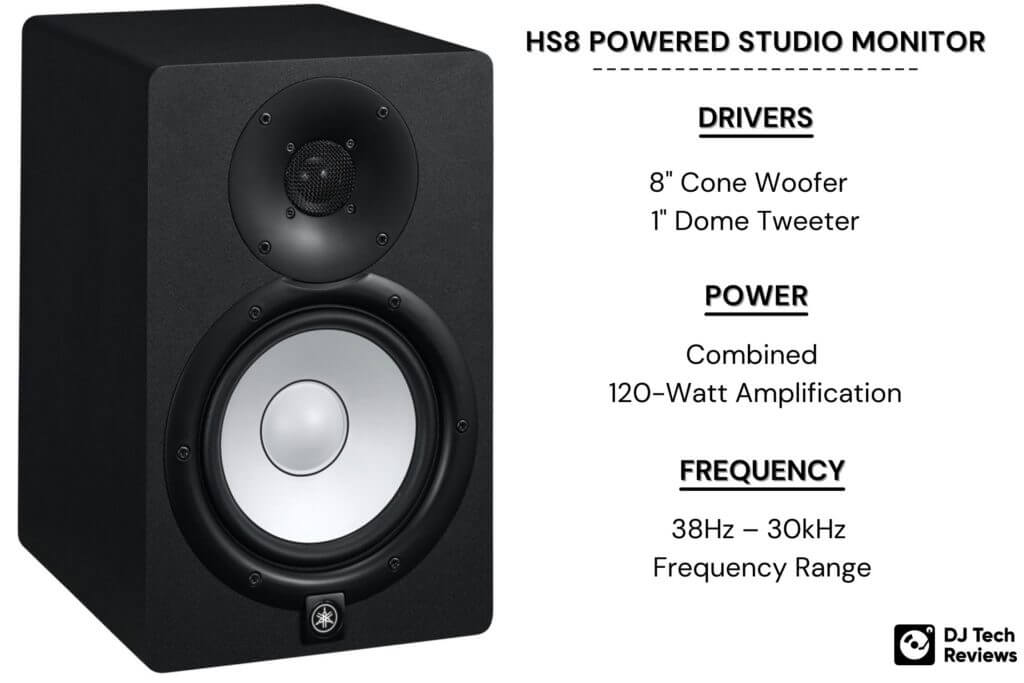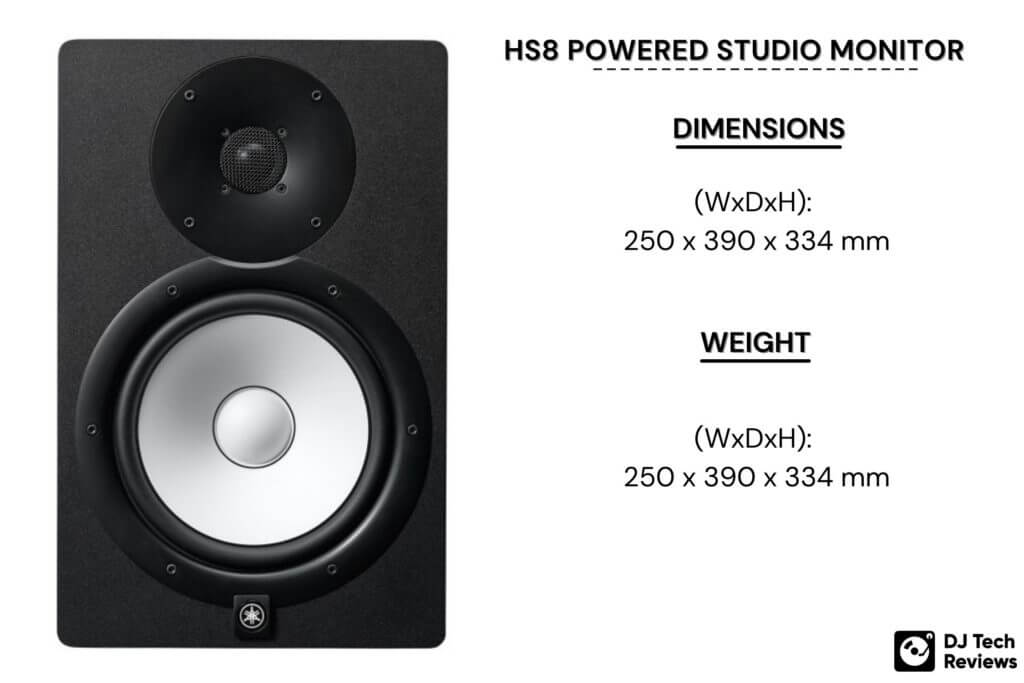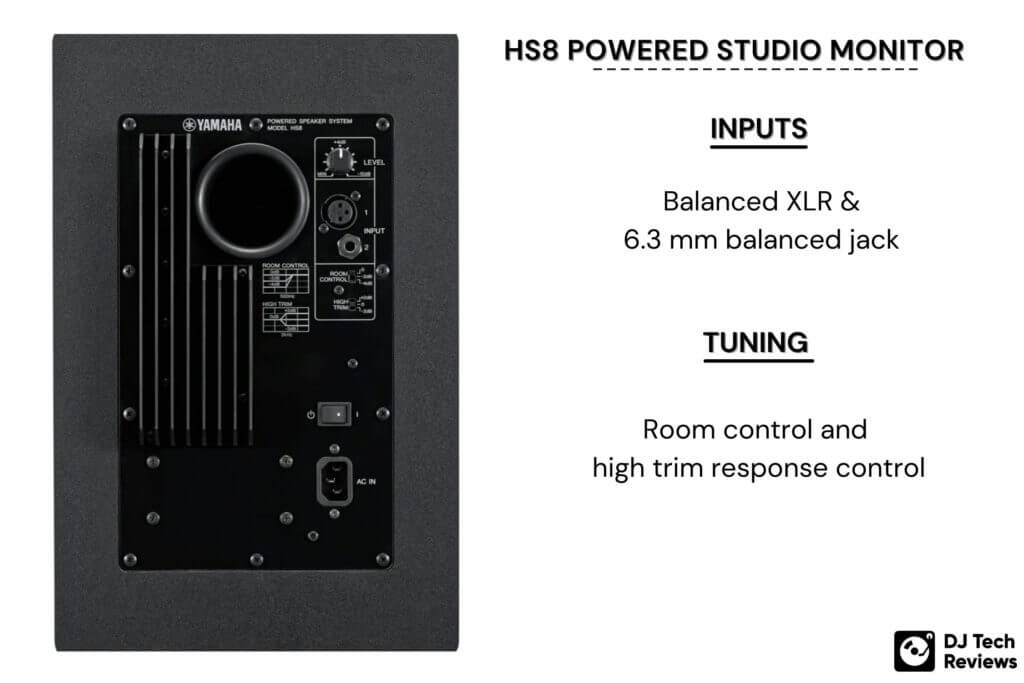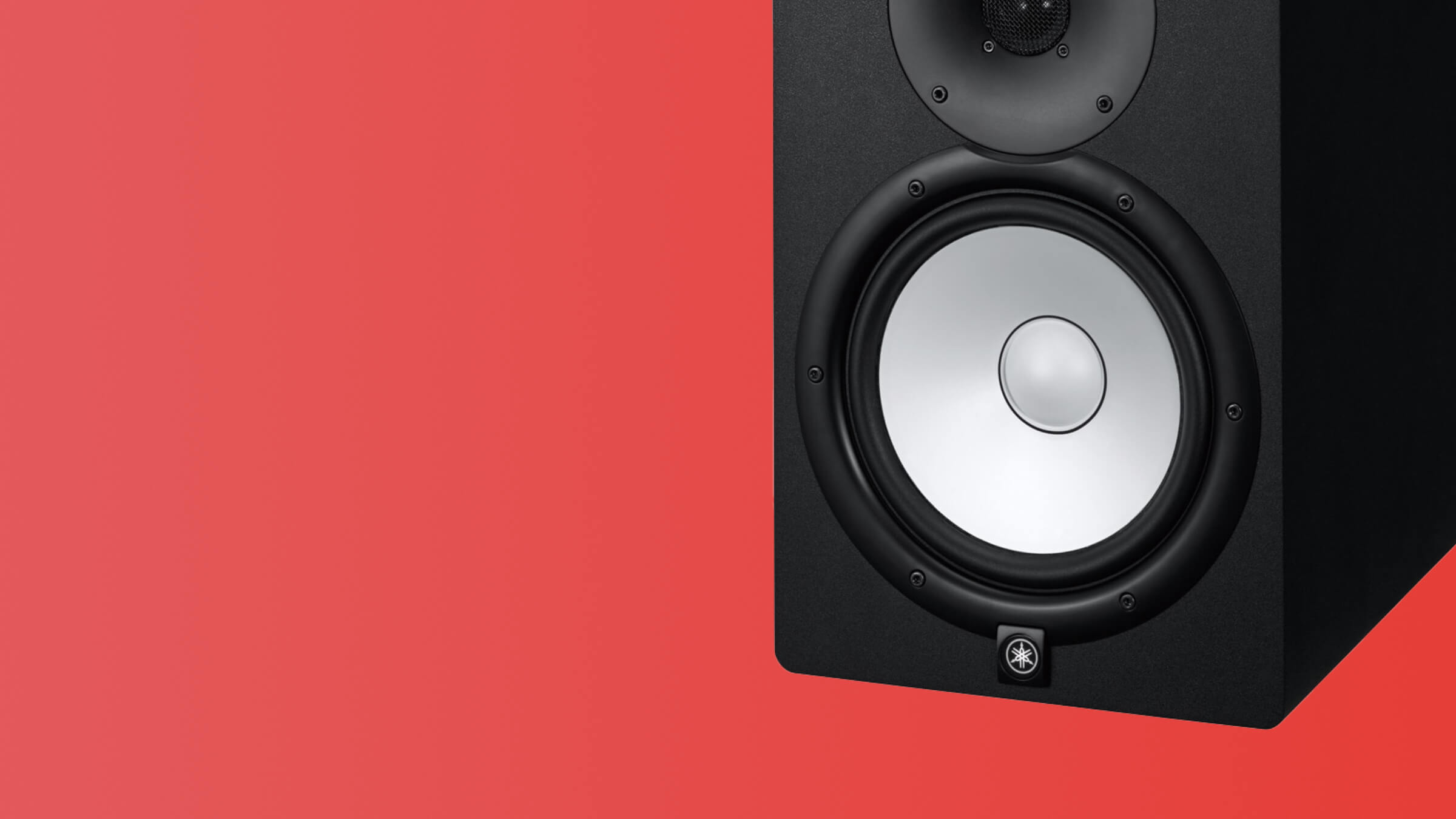Today we will be taking a look at the popular Yamaha HS8 studio monitors. We all know that one of the biggest challenges that can come with setting up your own studio space is deciding what type of studio reference monitors you’ll be using.
On top of just knowing about how well they sound or what options they have, you’ll also need to know how big they’ll have to be.
For example, 5-inch studio monitors may work great in a smaller-sized music production studio but they’d be pretty frustrating to deal with in most larger-sized areas.
There are a lot of benefits that come with larger 8-inch studio monitors.
They not only cover a larger area than smaller ones, but they often have more options, an improved sound quality, and rarely need a supplemental subwoofer for their lower ends.

In exchange, you’ll be paying a much prettier penny than the more entry-level options while also having some potentially daunting additions for people that only need a couple of things.
In this overview, we’ll be going over Yamaha’s bigger HS series monitors, the HS8 speaker set. This 8-inch monitor speaker is said to be ideal for people interested in a deeper low while also having a much larger studio to work with.
Will it live up to the task and deliver an awesome addition to the Yamaha lineup, or is it potentially just a bit too big for what its audience is looking for?
Yamaha has always been known for its incredible studio monitors. They are an industry leader in the nearfield reference monitors field due to consistent accuracy and a smooth response throughout the audio spectrum.
Will that hold true for the HS8 monitor speakers as well?
Let’s find out…
Are the Yamaha HS8 speakers any good? (in short)
Yes! They are excellent. They are powerful so do ensure sure you have the right size studio space to install this size of nearfield studio monitor. The Yamaha HS8 is a very accurate monitor. It has a deep low end, well-defined mids, and crisp tops. They are a solid investment for a studio at a relatively reasonable cost.
First Impressions – The Physical Build
When it comes to putting together a solid speaker, Yamaha has been around the block more than once. They know what they’re doing and it shows.
Upon opening the box, my first impressions were that I was definitely messing with something that could stand up to pretty much anything I threw against it. With a body made from dense MDF board, the HS8 is both incredibly durable as well as resilient.
Not only that, but the MDF body also works to reduce any sound resonance, keeping things focused where they should be.
In terms of visuals, Yamaha’s HS8 pulls from the rest of their lineup with the signature black-on-white piano design.
You can have either the all-black speaker body with the white woofer or the all-white speaker body with a black ring around the white woofer.

The Specs
One thing to always remember when dealing with larger speakers is that you’re dealing with larger speakers. As I started this out, one of the biggest challenges with deciding on what you’ll get is determining your studio space’s size in relation to the size of your speakers, and vice-versa.
A smaller studio monitor may not have as much power or sound ability as something like the Yamaha HS8, but if that’s all your space can afford to accommodate, you’d be silly to try and cram a huge speaker in there.
The same is true in the opposite direction.
If you’ve got a relatively large space, it’s going to be essential that you have something like the HS8 just to hear it from a good place.
Now that that’s said, let’s talk specs!
The Yamaha HS8 has an 8-inch cone woofer that is coupled alongside a high-performance 1-inch dome tweeter. It has a frequency response range between 38Hz and 30kHz, meaning you’re going to have a really smooth sound at every level.
It also comes with what is known as a bi-amp design. This essentially gives both the woofer and tweeter a dedicated amp to use.
And, while this is normally meant for the more prohibitively expensive speaker setups, it’s also the main reason the HS8’s sound is as flat and as smooth as it is.
Spec Breakdown
- Length: 15.4 inches (391mm)
- Width: 9.8 inches (249mm)
- Depth: 13.1 inches (333mm)
- Weight: 22.5 lbs. (10.2kg)
- Woofer Size: 8 inches
- Tweeter Size: 1 inch
- Frequency Range: 38Hz – 30kHz
- Wattage: 50
- Amp Class: AB
The Design
One thing that I really love about the Yamaha HS8 is it’s simple, yet understated design setup. It doesn’t come with anything super overtly flamboyant or flashy while also straying away from just another standard speaker look.
They come with two separate design choices: the all-white or the all-black with a white dome.
Both options are pretty striking while never moving into the unprofessional / “party guy” look.
Like the HS5, the HS8 can also be mounted and installed on your wall. While I personally keep mine on the floor, the dedicated mounting points and screws can make the mounting process fairly easy.

Taking A Deeper Look – Features & Sound Quality
So we’ve had a chance to go over the speaker build and overall design. Now, let’s get into the HS8’s different features; from its sound quality to its different tuning and connectivity options.
Sound Quality
When compared to Yamaha’s smaller HS5 model, the HS8 easily overtakes its smaller brother in pretty much every area.
It’s larger, has more reach, and has greater sound clarity. This isn’t even mentioning the dramatic improvements to the bass.
What It Gets Right
As mentioned earlier, the HS8 pretty much outstrips the HS5 in every area. This makes sense due to being a larger and higher-quality speaker set.
But even stepping away from direct comparison, the HS8 is simply an incredible studio monitor based on any metric.
The HS Series features transducers that achieve insanely smooth responses over a range of frequencies.
Its sound balancing across all three frequencies (high, mid, and low) is stellar with a very neutral flat response.
Not only is this great for the audiophiles out there that enjoy hearing music in its purest form, but DJs and music producers will be able to hear their mixing and mastering actually affect and impact the music overall.
Specifically touching on the three frequencies, the highs are incredibly clean with a noticeable crispness. Similarly, the mid-level frequencies have a wide amount of depth while also being very warm and inviting.
The breakout star, however, is none other than the lows. If you were to compare them to the HS5s, it would be like night and day.
Whereas those couldn’t do much without a subwoofer to amp them up, the HS8 handles bass like a pro.
While you can certainly throw on a sub if you’re someone interested in feeling it in your bones, 99% of people can run these as-is and still enjoy virtually all bass-heavy music, complete with meaty and satisfying beats and thumps.

HS8 Features Offered
Connection Options
The HS8’s connection options include both the XLR and the TRS points. This ensures that you’ll be able to access both balanced as well as unbalanced signals when connecting your speakers.
While they don’t have a connection for every outlet (most particularly the RCA connection), they can connect their speakers to pretty much all available options, either through adapters or with just the cords themselves.
Tuning Options
One of the things I’m always interested in is whether a speaker set comes with any tuning or sound alteration options.
These essentially make a studio monitor work in pretty much any environment or setting space by tweaking its EQ.
The HS8 offers extra room-matching tuning options and speaker placement versatility with the MID EQ (giving you a subtle midrange boost ), the HIGH TRIM, and “room control” response control switches.
The tuning options allow you to tune and adjust the high and low frequencies to best balance out the speakers in your area.
These are specifically designed to compensate for commonly found acoustic deficiencies and monitoring adjustments.
My biggest “meh” here is probably just the fact that it doesn’t come with much more than that. It’s well enough as it is, yes.
However, if you want more than what it offers, you’re kind of out of luck.
Final Thoughts – Is it Worth Your Time?
When it comes to the Yamaha HS8, there aren’t a lot of things to consider. Particularly if you’ve been a fan of their HS5 or similarly priced entry-point speakers, you’ll note that the HS8 outpaces every one of their strengths, while completely removing every one of their weaknesses.
It’d feel weird calling the HS8 a “perfect studio monitor”, but I honestly can’t think of anything wrong with it.
So, simply put, when asking whether the Yamaha HS8 is worth your time, the answer is a categorical “Absolutely… with a caveat.”
Besides price, the only real thing I can think of that would make people question the speakers overall, is their size. If you’re someone that simply does not have the space, getting the HS8 is pretty much going to be overkill.
Either you’ll end up going deaf and upsetting your neighbors, or you’re essentially only going to drive a Lamborghini in New York City (ie., won’t actually use more than half of your speakers’ power).
If you do have the room, and you can swing the cost, Yamaha’s HS8s really do hit every single mark while making it kind of seem easy.
You kind of owe it to yourself to at least consider looking at this incredible specimen of a speaker.

Pros & Cons
Pros
- Extremely Well Put Together Build
- Very Punchy Bass Output
- Has Impressive Sound Clarity
- Hosts A Range of Tuning Options
- Can Be Installed In Several Places
Cons
- A Bit On The Pricier Side
- Much too powerful for many smaller studio locations
Yamaha HS8 Monitor Speakers: The Verdict
There are a lot of different speakers out there that do a lot of the things that the Yamaha HS8 does. The reality, however, is that very few speakers do what the Yamaha HS8 does as well as they do it, particularly those that are cheaper than this.
8-inch monitors can certainly get pricey and expensive. This is due to the high amounts of quality materials used as well as the incredible sound quality that’s offered.
What’s interesting is that, when you look at it from that perspective, it becomes only obvious for the pricing, and in fact, may actually turn out that you’re getting the better end of a deal for your cost.
On top of that, you’ll need to make sure you have the right amount of space before making the decision.
While I can’t say you should double mortgage your house or rob a bank to get the money, nor buy into a house that you can’t afford just to have the space, the simple fact of the matter is that there is any reason not to get them outside of those two areas.
The best compromise I can think of is if you’re not able to buy this outright, strongly consider getting the HS5 and using that until you’re in a situation where you can get the HS8.
They seriously have it all. Clarity, Punchiness, and a very solid bottom-end response!
What more do you want?
Let us know your thoughts in the comments below!




